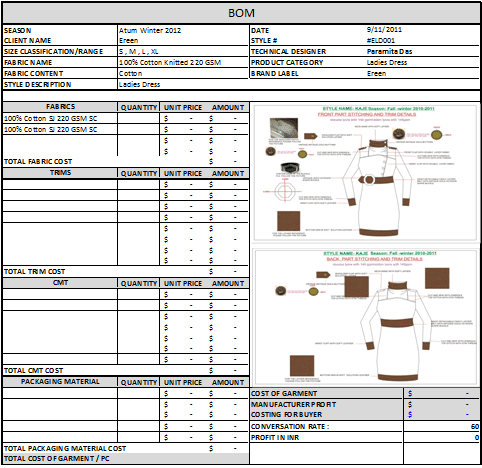A garment Cost Sheet is a crucial document to prepare to get a proper estimate of a collection design and production. It gives you, if not precisely, an approximate cost to execute apparel design and production for a collection. Here are detailed guidelines on how you can prepare a garment cost sheet. Additionally, you can obtain a format for the garment cost sheet. You can use this to prepare your cost and estimated profit from the collection drop. Remember to prepare the cost sheet properly; you need to have your tech packs in order. Your tech pack designer must mention all the details you want to put in your garment. This clarifies your style and makes preparing a proper garment costing sheet easier.
What is the Garment Cost Sheet?
A garment cost sheet is prepared to calculate the cost of one piece of garment. It includes the material cost and the cost of processing. Production quantity is also a crucial factor in determining costs. This subject can be complicated, so let me explain it step by step, using an example to clarify. That’s how we can make understanding the concept of preparing a garment cost sheet easier. The cost and profit are directly related to fashion design and production pricing. So, the fashion design is directly proportional to production pricing.
Header Information
Header information on a garment cost sheet includes all the details about the style. The details are Style Name, Style Number (SKU), Category, Designer, Season, Country of Production, etc. From this, you can identify the style for which the cost is calculated.
Bill of Materials (BOM)
List all the materials required for the garment, including fabric, lining, buttons, zippers, labels, etc. Specify quantities, units of measurement, and unit costs for each material. The product developer and tech pack designer should work together to create the Bills of Materials, a crucial part of the tech pack. A small mistake in the bills of materials can lead to a high deviation in the cost, so it should be done with utmost care.
Labor Costs
Break down the labor costs associated with the garment. This includes the cost of cutting, sewing, finishing, and any additional labor processes. Specify the hours required for each task and the corresponding labor rates. Calculating the labor cost is a complicated process. Some factories do it based on the operations of one style. Manufacturers calculate the number of operations and the cost of performing each operation. Then, they come up with the total labor cost.
Overhead Costs
Factor in overhead costs, which include expenses beyond direct materials and labor. This may include utilities, rent, support staff salaries, equipment depreciation, etc. Allocate a portion of these costs to each garment based on a predetermined formula.
Profit Margin
Determine the desired profit margin for the garment. This is usually a percentage of the total production cost. It’s crucial to strike a balance between competitiveness and profitability. Typically, manufacturers keep 15 %—22 % on each garment production in garment industries. The profit margin increases or decreases depending on the risk and wastage factors. If the garment is risky or complicated, the profit margin goes up.
Transportation and Logistics
Include costs of transporting raw materials to the manufacturing facility and finished goods to distribution centers or retailers. Consider shipping, customs duties, and any other logistics expenses. While companies usually calculate internal logistic costs from one unit to another using miscellaneous expenses, these costs should be calculated under a specific head for accurate accounting.
Packaging Costs
Account for the cost of packaging materials and the labor required to package the finished garments. This may include boxes, tags, labels, and other packaging components. The client usually provides tags, labels, and other branding materials. If the client offers those, the only remaining packaging costs would be the carton boxes, duct tape, and poly bags for garments.
Quality Control
Allocate funds for quality control processes to ensure the final product meets the specified standards. This may involve hiring quality inspectors or implementing quality control measures in production. The process varies from client to client. Some clients include this with the manufacturing cost, and some do it externally.
Miscellaneous Costs
Consider any additional costs that may arise during production, such as tech pack design, sample development, pattern making, or prototyping. Also, account for any unexpected expenses that may occur.
Total Cost Calculation
Sum up all the abovementioned costs to determine the total production cost for each garment unit. This total cost is a critical figure that will help determine the pricing strategy.
Pricing Strategy
Determine the selling price of the garment based on the total cost. Consider market trends, competitor pricing, and your brand positioning when setting the final retail price. Typically, the ratio is 1:3, meaning the selling price is three times the total cost.
Documentation
Keep a detailed record of all the cost components and calculations for future reference. This documentation is essential for making informed decisions, conducting cost analyses, and refining your cost structure.
Why We Need to Calculate Cost?
Before writing about the garment cost sheet, I searched Google for clear articles but found nothing. Businesses are often reluctant to provide a clear breakdown of their material costs. They call it a business secret. No clothing manufacturer will give you open costing. They will provide you with one final cost per garment. However, it is your responsibility to determine a sensible cost for a garment. Creating a cost sheet becomes challenging when you lack detailed knowledge of garment construction. And you end up losing a lot of money in production. To keep track of your expenses. You can prepare a cost sheet with a tech pack in hand. A tech pack designer can give you the details that help prepare your cost sheet.
Visit the Tech Pack Template Store if you are starting a brand with styles everyone uses with your brand name or some graphics artwork to customize. You can buy the tech packs to send to clothing manufacturers, add your graphic artwork and logos with this tech pack template, and save hundreds of dollars. We develop fashion spec sheet templates and test them several times in production. Ideally, we will finalize the spec sheet once the measurements come out. For a proper clothing manufacturing cost estimation, it’s essential to have an appropriate tech design pack. By following these steps, you can prepare a comprehensive garment cost sheet. This approach considers all aspects of production, helping you make informed decisions about pricing and ensuring the financial viability of your garment.

